BSBLDR802: Analyzing and Leading the Strategic Planning Process
VerifiedAdded on 2022/07/28
|13
|2891
|27
Report
AI Summary
This report delves into the BSBLDR802 unit, focusing on the strategic planning process within an organization. It covers crucial aspects such as contractual and financial management requirements, research methodologies, and the resources needed for project undertaking. The report outlines the process of identifying strategic goals, including goal setting analysis, strategy formulation, and SWOT analysis, and details the steps involved in developing and implementing strategic and operational plans. Key elements like stakeholder engagement, risk assessment, and employee engagement are also discussed, alongside tools for performance evaluation and steps for plan modification. Furthermore, the report emphasizes the role of HR, succession strategies, workforce skill enhancement, communication strategies, and monitoring processes to ensure effective strategic planning and execution. The document also highlights the importance of leadership and the key result areas for establishing leadership to achieve organizational goals effectively.
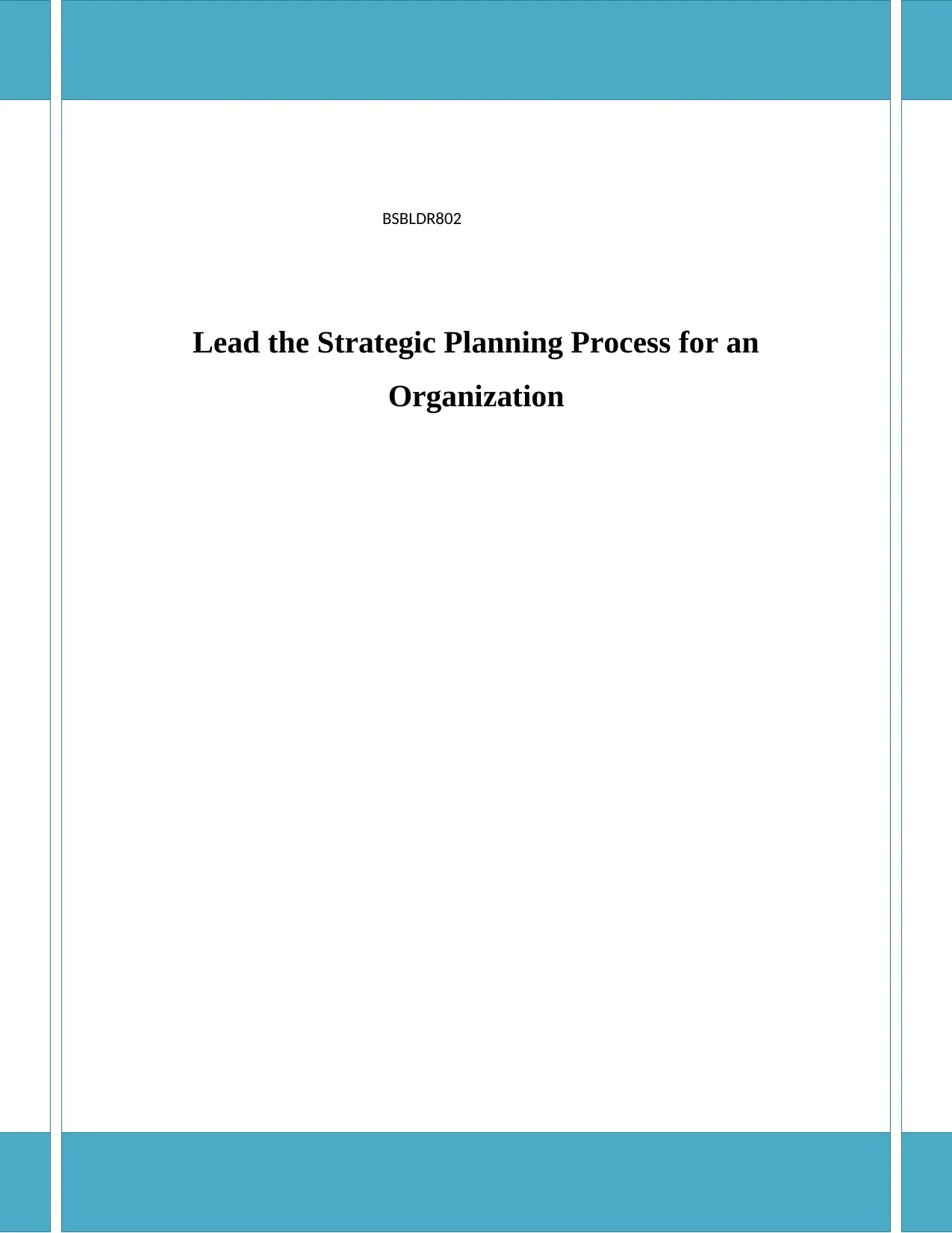
BSBLDR802
Lead the Strategic Planning Process for an
Organization
Lead the Strategic Planning Process for an
Organization
Paraphrase This Document
Need a fresh take? Get an instant paraphrase of this document with our AI Paraphraser
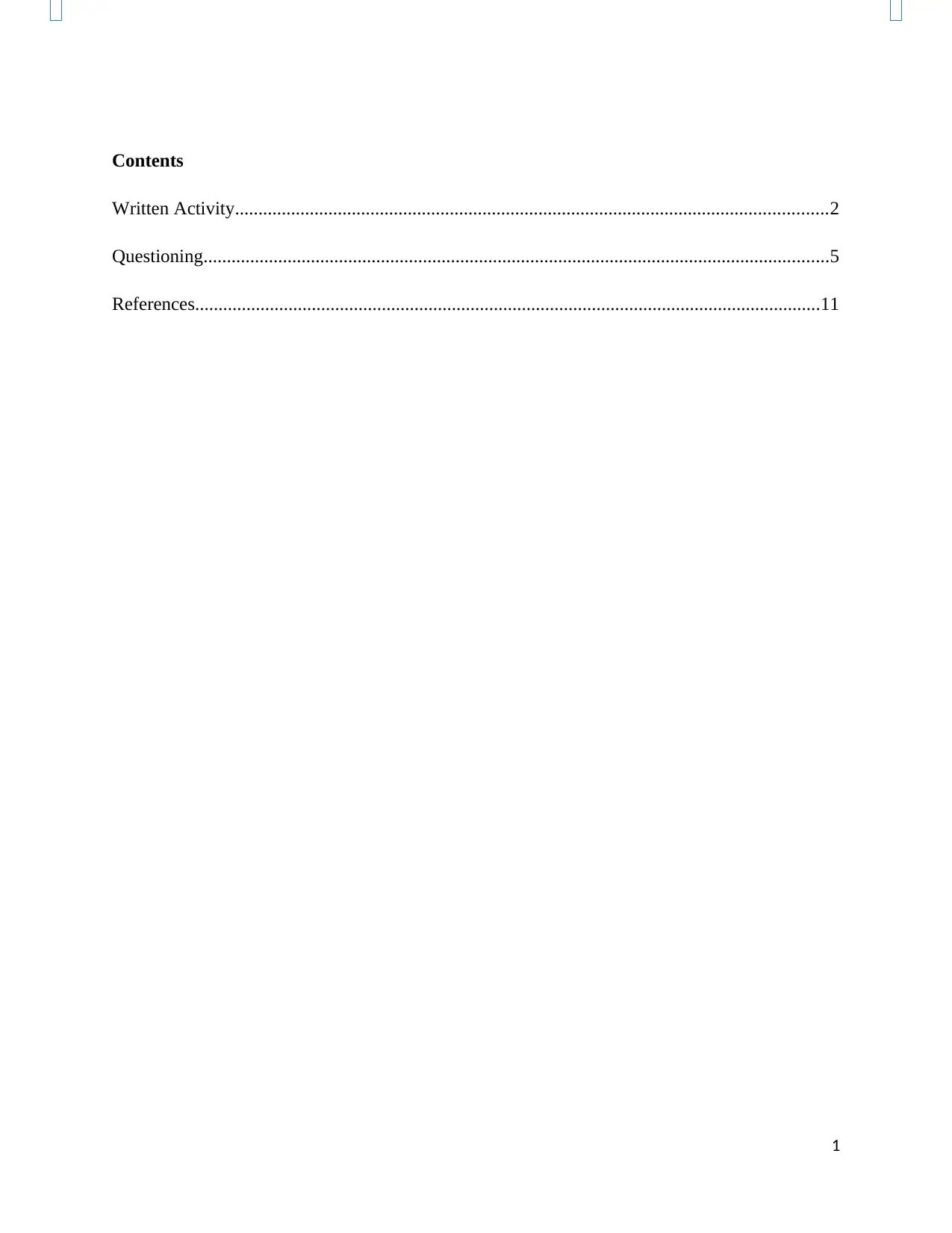
Contents
Written Activity...............................................................................................................................2
Questioning......................................................................................................................................5
References......................................................................................................................................11
1
Written Activity...............................................................................................................................2
Questioning......................................................................................................................................5
References......................................................................................................................................11
1
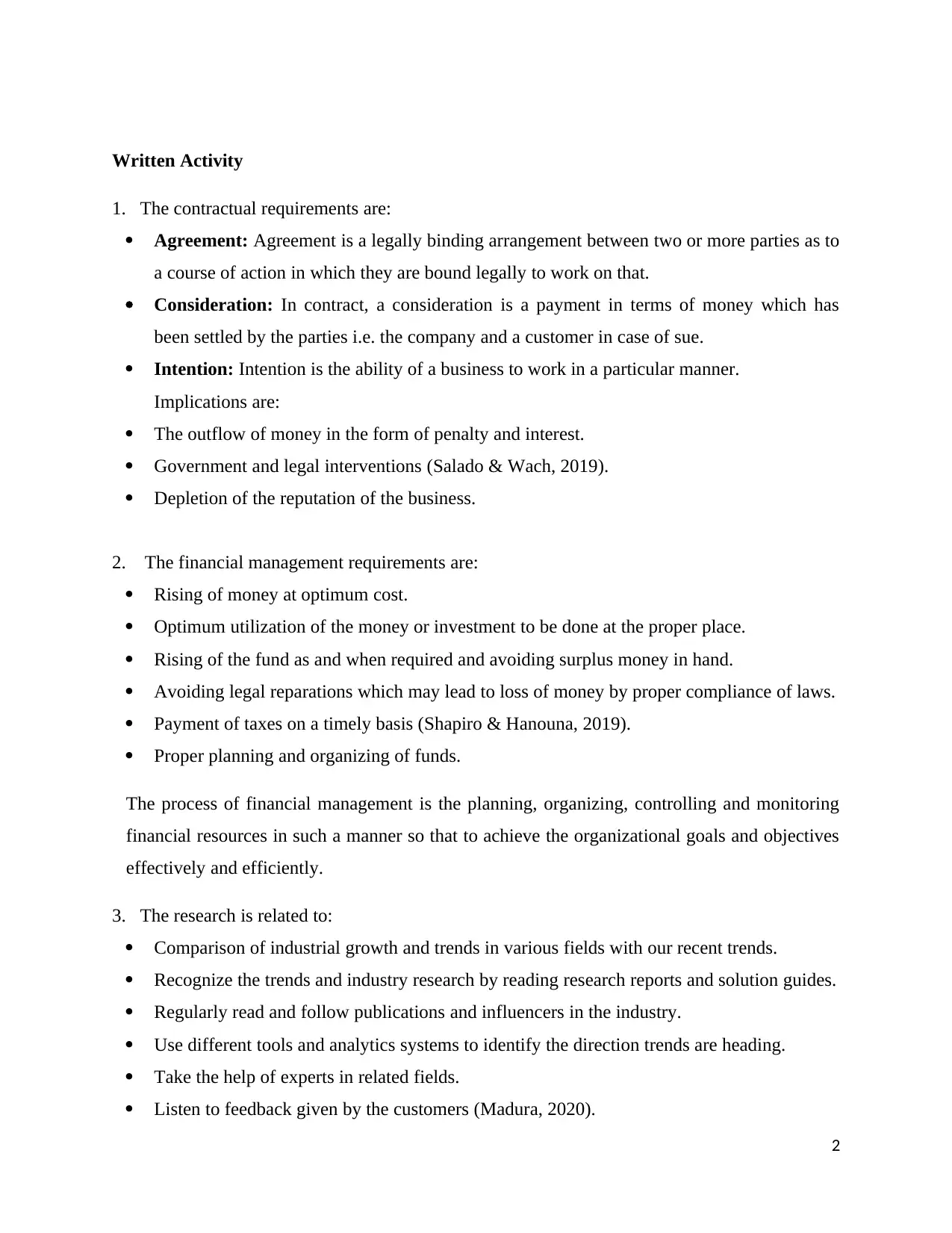
Written Activity
1. The contractual requirements are:
Agreement: Agreement is a legally binding arrangement between two or more parties as to
a course of action in which they are bound legally to work on that.
Consideration: In contract, a consideration is a payment in terms of money which has
been settled by the parties i.e. the company and a customer in case of sue.
Intention: Intention is the ability of a business to work in a particular manner.
Implications are:
The outflow of money in the form of penalty and interest.
Government and legal interventions (Salado & Wach, 2019).
Depletion of the reputation of the business.
2. The financial management requirements are:
Rising of money at optimum cost.
Optimum utilization of the money or investment to be done at the proper place.
Rising of the fund as and when required and avoiding surplus money in hand.
Avoiding legal reparations which may lead to loss of money by proper compliance of laws.
Payment of taxes on a timely basis (Shapiro & Hanouna, 2019).
Proper planning and organizing of funds.
The process of financial management is the planning, organizing, controlling and monitoring
financial resources in such a manner so that to achieve the organizational goals and objectives
effectively and efficiently.
3. The research is related to:
Comparison of industrial growth and trends in various fields with our recent trends.
Recognize the trends and industry research by reading research reports and solution guides.
Regularly read and follow publications and influencers in the industry.
Use different tools and analytics systems to identify the direction trends are heading.
Take the help of experts in related fields.
Listen to feedback given by the customers (Madura, 2020).
2
1. The contractual requirements are:
Agreement: Agreement is a legally binding arrangement between two or more parties as to
a course of action in which they are bound legally to work on that.
Consideration: In contract, a consideration is a payment in terms of money which has
been settled by the parties i.e. the company and a customer in case of sue.
Intention: Intention is the ability of a business to work in a particular manner.
Implications are:
The outflow of money in the form of penalty and interest.
Government and legal interventions (Salado & Wach, 2019).
Depletion of the reputation of the business.
2. The financial management requirements are:
Rising of money at optimum cost.
Optimum utilization of the money or investment to be done at the proper place.
Rising of the fund as and when required and avoiding surplus money in hand.
Avoiding legal reparations which may lead to loss of money by proper compliance of laws.
Payment of taxes on a timely basis (Shapiro & Hanouna, 2019).
Proper planning and organizing of funds.
The process of financial management is the planning, organizing, controlling and monitoring
financial resources in such a manner so that to achieve the organizational goals and objectives
effectively and efficiently.
3. The research is related to:
Comparison of industrial growth and trends in various fields with our recent trends.
Recognize the trends and industry research by reading research reports and solution guides.
Regularly read and follow publications and influencers in the industry.
Use different tools and analytics systems to identify the direction trends are heading.
Take the help of experts in related fields.
Listen to feedback given by the customers (Madura, 2020).
2
⊘ This is a preview!⊘
Do you want full access?
Subscribe today to unlock all pages.

Trusted by 1+ million students worldwide
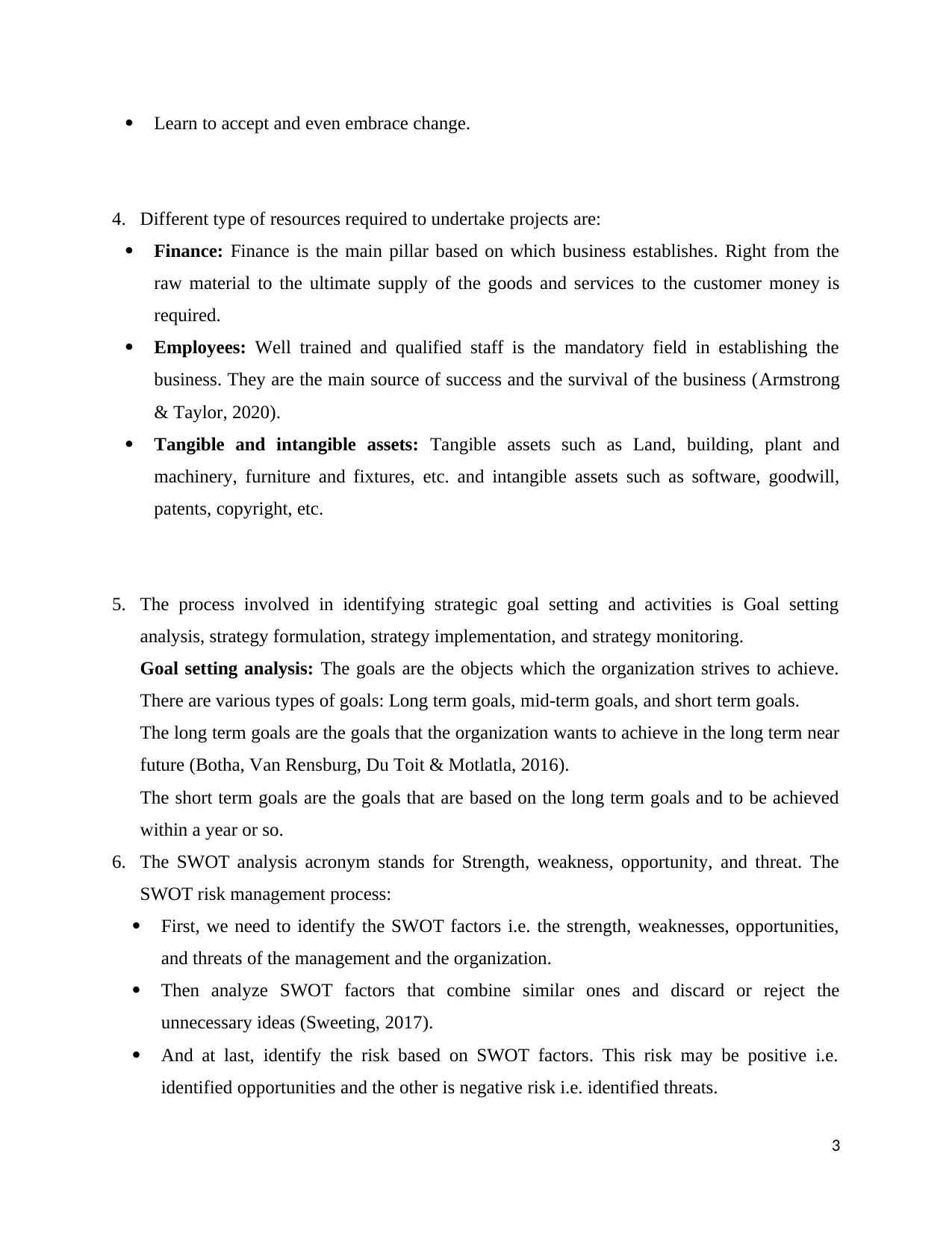
Learn to accept and even embrace change.
4. Different type of resources required to undertake projects are:
Finance: Finance is the main pillar based on which business establishes. Right from the
raw material to the ultimate supply of the goods and services to the customer money is
required.
Employees: Well trained and qualified staff is the mandatory field in establishing the
business. They are the main source of success and the survival of the business (Armstrong
& Taylor, 2020).
Tangible and intangible assets: Tangible assets such as Land, building, plant and
machinery, furniture and fixtures, etc. and intangible assets such as software, goodwill,
patents, copyright, etc.
5. The process involved in identifying strategic goal setting and activities is Goal setting
analysis, strategy formulation, strategy implementation, and strategy monitoring.
Goal setting analysis: The goals are the objects which the organization strives to achieve.
There are various types of goals: Long term goals, mid-term goals, and short term goals.
The long term goals are the goals that the organization wants to achieve in the long term near
future (Botha, Van Rensburg, Du Toit & Motlatla, 2016).
The short term goals are the goals that are based on the long term goals and to be achieved
within a year or so.
6. The SWOT analysis acronym stands for Strength, weakness, opportunity, and threat. The
SWOT risk management process:
First, we need to identify the SWOT factors i.e. the strength, weaknesses, opportunities,
and threats of the management and the organization.
Then analyze SWOT factors that combine similar ones and discard or reject the
unnecessary ideas (Sweeting, 2017).
And at last, identify the risk based on SWOT factors. This risk may be positive i.e.
identified opportunities and the other is negative risk i.e. identified threats.
3
4. Different type of resources required to undertake projects are:
Finance: Finance is the main pillar based on which business establishes. Right from the
raw material to the ultimate supply of the goods and services to the customer money is
required.
Employees: Well trained and qualified staff is the mandatory field in establishing the
business. They are the main source of success and the survival of the business (Armstrong
& Taylor, 2020).
Tangible and intangible assets: Tangible assets such as Land, building, plant and
machinery, furniture and fixtures, etc. and intangible assets such as software, goodwill,
patents, copyright, etc.
5. The process involved in identifying strategic goal setting and activities is Goal setting
analysis, strategy formulation, strategy implementation, and strategy monitoring.
Goal setting analysis: The goals are the objects which the organization strives to achieve.
There are various types of goals: Long term goals, mid-term goals, and short term goals.
The long term goals are the goals that the organization wants to achieve in the long term near
future (Botha, Van Rensburg, Du Toit & Motlatla, 2016).
The short term goals are the goals that are based on the long term goals and to be achieved
within a year or so.
6. The SWOT analysis acronym stands for Strength, weakness, opportunity, and threat. The
SWOT risk management process:
First, we need to identify the SWOT factors i.e. the strength, weaknesses, opportunities,
and threats of the management and the organization.
Then analyze SWOT factors that combine similar ones and discard or reject the
unnecessary ideas (Sweeting, 2017).
And at last, identify the risk based on SWOT factors. This risk may be positive i.e.
identified opportunities and the other is negative risk i.e. identified threats.
3
Paraphrase This Document
Need a fresh take? Get an instant paraphrase of this document with our AI Paraphraser
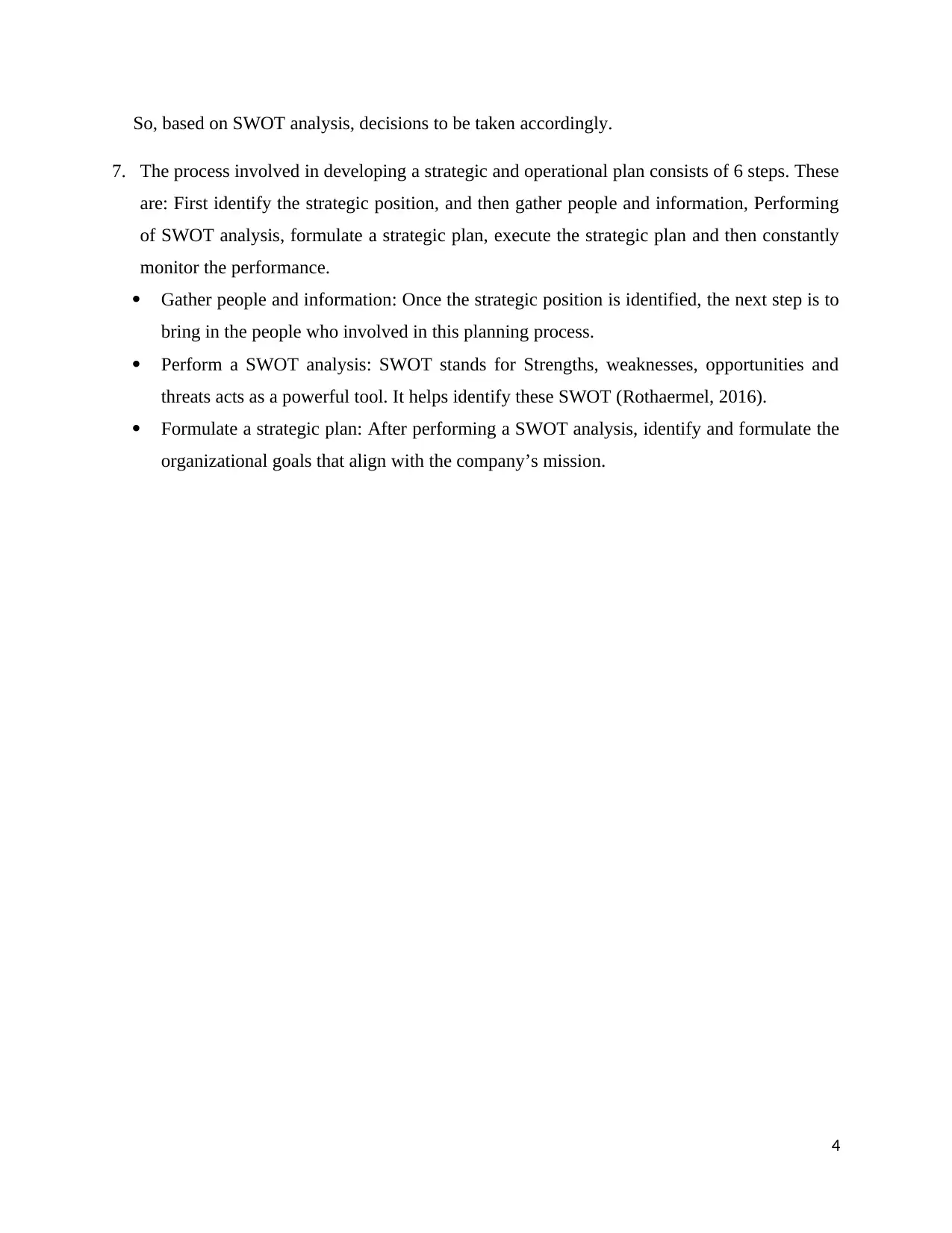
So, based on SWOT analysis, decisions to be taken accordingly.
7. The process involved in developing a strategic and operational plan consists of 6 steps. These
are: First identify the strategic position, and then gather people and information, Performing
of SWOT analysis, formulate a strategic plan, execute the strategic plan and then constantly
monitor the performance.
Gather people and information: Once the strategic position is identified, the next step is to
bring in the people who involved in this planning process.
Perform a SWOT analysis: SWOT stands for Strengths, weaknesses, opportunities and
threats acts as a powerful tool. It helps identify these SWOT (Rothaermel, 2016).
Formulate a strategic plan: After performing a SWOT analysis, identify and formulate the
organizational goals that align with the company’s mission.
4
7. The process involved in developing a strategic and operational plan consists of 6 steps. These
are: First identify the strategic position, and then gather people and information, Performing
of SWOT analysis, formulate a strategic plan, execute the strategic plan and then constantly
monitor the performance.
Gather people and information: Once the strategic position is identified, the next step is to
bring in the people who involved in this planning process.
Perform a SWOT analysis: SWOT stands for Strengths, weaknesses, opportunities and
threats acts as a powerful tool. It helps identify these SWOT (Rothaermel, 2016).
Formulate a strategic plan: After performing a SWOT analysis, identify and formulate the
organizational goals that align with the company’s mission.
4
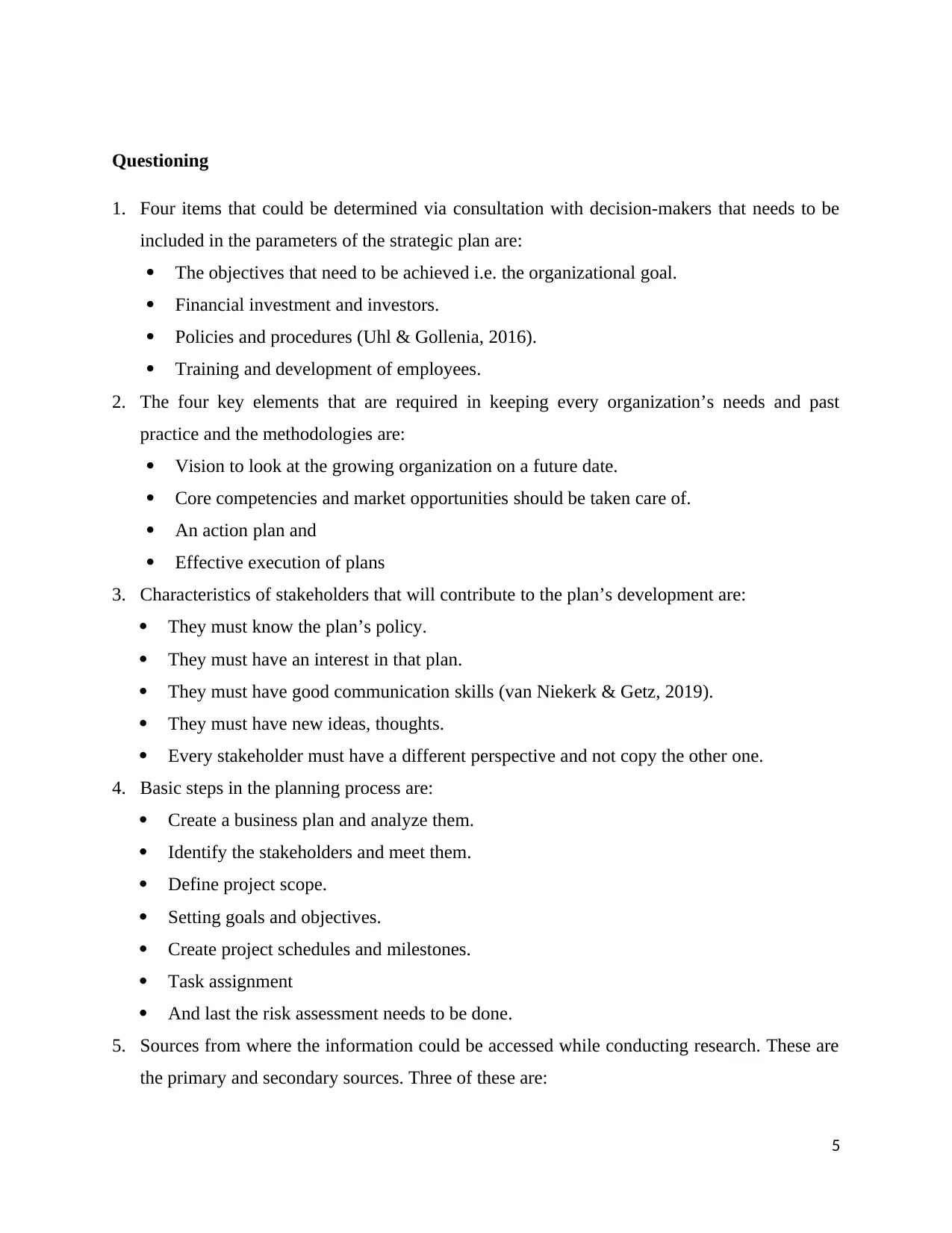
Questioning
1. Four items that could be determined via consultation with decision-makers that needs to be
included in the parameters of the strategic plan are:
The objectives that need to be achieved i.e. the organizational goal.
Financial investment and investors.
Policies and procedures (Uhl & Gollenia, 2016).
Training and development of employees.
2. The four key elements that are required in keeping every organization’s needs and past
practice and the methodologies are:
Vision to look at the growing organization on a future date.
Core competencies and market opportunities should be taken care of.
An action plan and
Effective execution of plans
3. Characteristics of stakeholders that will contribute to the plan’s development are:
They must know the plan’s policy.
They must have an interest in that plan.
They must have good communication skills (van Niekerk & Getz, 2019).
They must have new ideas, thoughts.
Every stakeholder must have a different perspective and not copy the other one.
4. Basic steps in the planning process are:
Create a business plan and analyze them.
Identify the stakeholders and meet them.
Define project scope.
Setting goals and objectives.
Create project schedules and milestones.
Task assignment
And last the risk assessment needs to be done.
5. Sources from where the information could be accessed while conducting research. These are
the primary and secondary sources. Three of these are:
5
1. Four items that could be determined via consultation with decision-makers that needs to be
included in the parameters of the strategic plan are:
The objectives that need to be achieved i.e. the organizational goal.
Financial investment and investors.
Policies and procedures (Uhl & Gollenia, 2016).
Training and development of employees.
2. The four key elements that are required in keeping every organization’s needs and past
practice and the methodologies are:
Vision to look at the growing organization on a future date.
Core competencies and market opportunities should be taken care of.
An action plan and
Effective execution of plans
3. Characteristics of stakeholders that will contribute to the plan’s development are:
They must know the plan’s policy.
They must have an interest in that plan.
They must have good communication skills (van Niekerk & Getz, 2019).
They must have new ideas, thoughts.
Every stakeholder must have a different perspective and not copy the other one.
4. Basic steps in the planning process are:
Create a business plan and analyze them.
Identify the stakeholders and meet them.
Define project scope.
Setting goals and objectives.
Create project schedules and milestones.
Task assignment
And last the risk assessment needs to be done.
5. Sources from where the information could be accessed while conducting research. These are
the primary and secondary sources. Three of these are:
5
⊘ This is a preview!⊘
Do you want full access?
Subscribe today to unlock all pages.

Trusted by 1+ million students worldwide
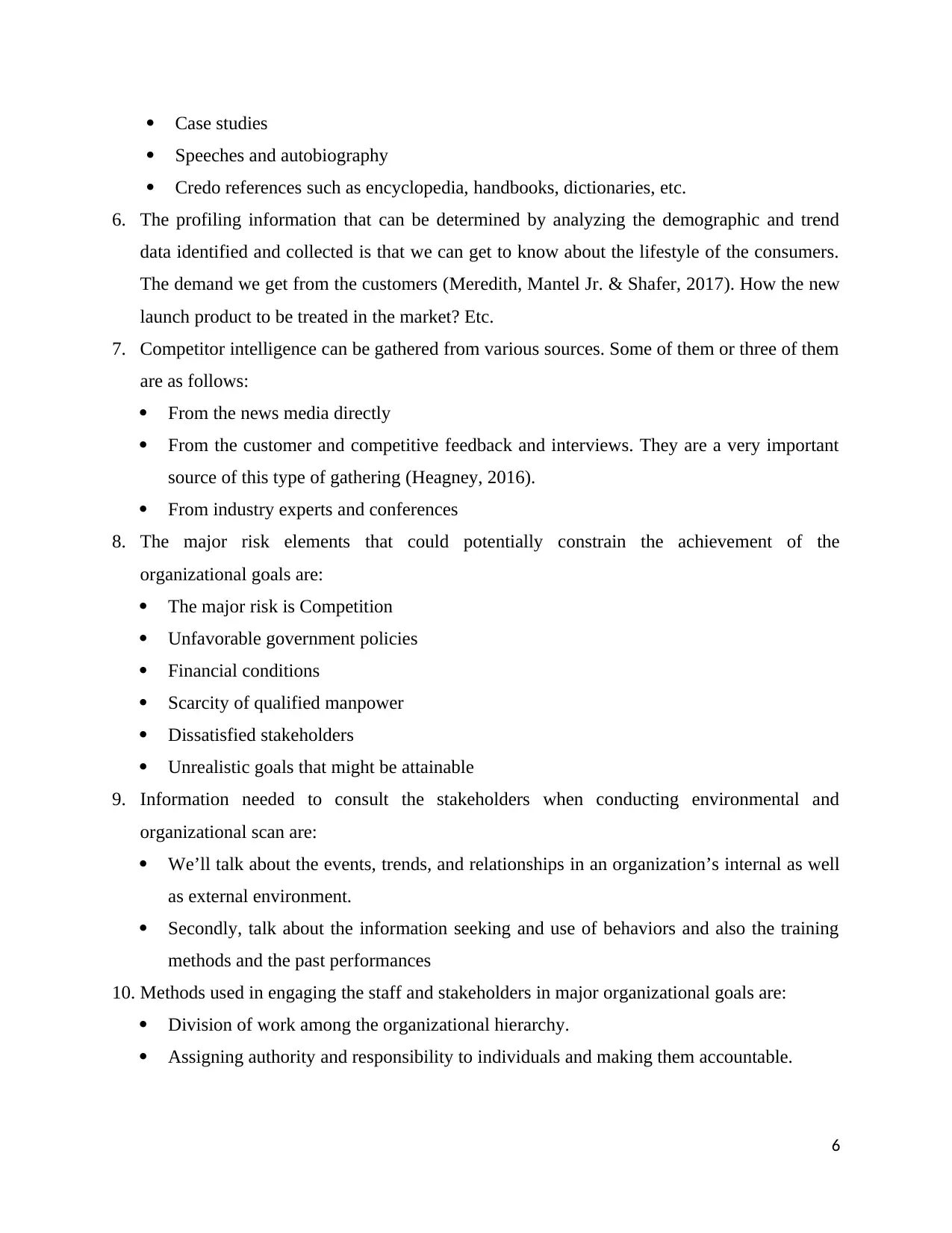
Case studies
Speeches and autobiography
Credo references such as encyclopedia, handbooks, dictionaries, etc.
6. The profiling information that can be determined by analyzing the demographic and trend
data identified and collected is that we can get to know about the lifestyle of the consumers.
The demand we get from the customers (Meredith, Mantel Jr. & Shafer, 2017). How the new
launch product to be treated in the market? Etc.
7. Competitor intelligence can be gathered from various sources. Some of them or three of them
are as follows:
From the news media directly
From the customer and competitive feedback and interviews. They are a very important
source of this type of gathering (Heagney, 2016).
From industry experts and conferences
8. The major risk elements that could potentially constrain the achievement of the
organizational goals are:
The major risk is Competition
Unfavorable government policies
Financial conditions
Scarcity of qualified manpower
Dissatisfied stakeholders
Unrealistic goals that might be attainable
9. Information needed to consult the stakeholders when conducting environmental and
organizational scan are:
We’ll talk about the events, trends, and relationships in an organization’s internal as well
as external environment.
Secondly, talk about the information seeking and use of behaviors and also the training
methods and the past performances
10. Methods used in engaging the staff and stakeholders in major organizational goals are:
Division of work among the organizational hierarchy.
Assigning authority and responsibility to individuals and making them accountable.
6
Speeches and autobiography
Credo references such as encyclopedia, handbooks, dictionaries, etc.
6. The profiling information that can be determined by analyzing the demographic and trend
data identified and collected is that we can get to know about the lifestyle of the consumers.
The demand we get from the customers (Meredith, Mantel Jr. & Shafer, 2017). How the new
launch product to be treated in the market? Etc.
7. Competitor intelligence can be gathered from various sources. Some of them or three of them
are as follows:
From the news media directly
From the customer and competitive feedback and interviews. They are a very important
source of this type of gathering (Heagney, 2016).
From industry experts and conferences
8. The major risk elements that could potentially constrain the achievement of the
organizational goals are:
The major risk is Competition
Unfavorable government policies
Financial conditions
Scarcity of qualified manpower
Dissatisfied stakeholders
Unrealistic goals that might be attainable
9. Information needed to consult the stakeholders when conducting environmental and
organizational scan are:
We’ll talk about the events, trends, and relationships in an organization’s internal as well
as external environment.
Secondly, talk about the information seeking and use of behaviors and also the training
methods and the past performances
10. Methods used in engaging the staff and stakeholders in major organizational goals are:
Division of work among the organizational hierarchy.
Assigning authority and responsibility to individuals and making them accountable.
6
Paraphrase This Document
Need a fresh take? Get an instant paraphrase of this document with our AI Paraphraser
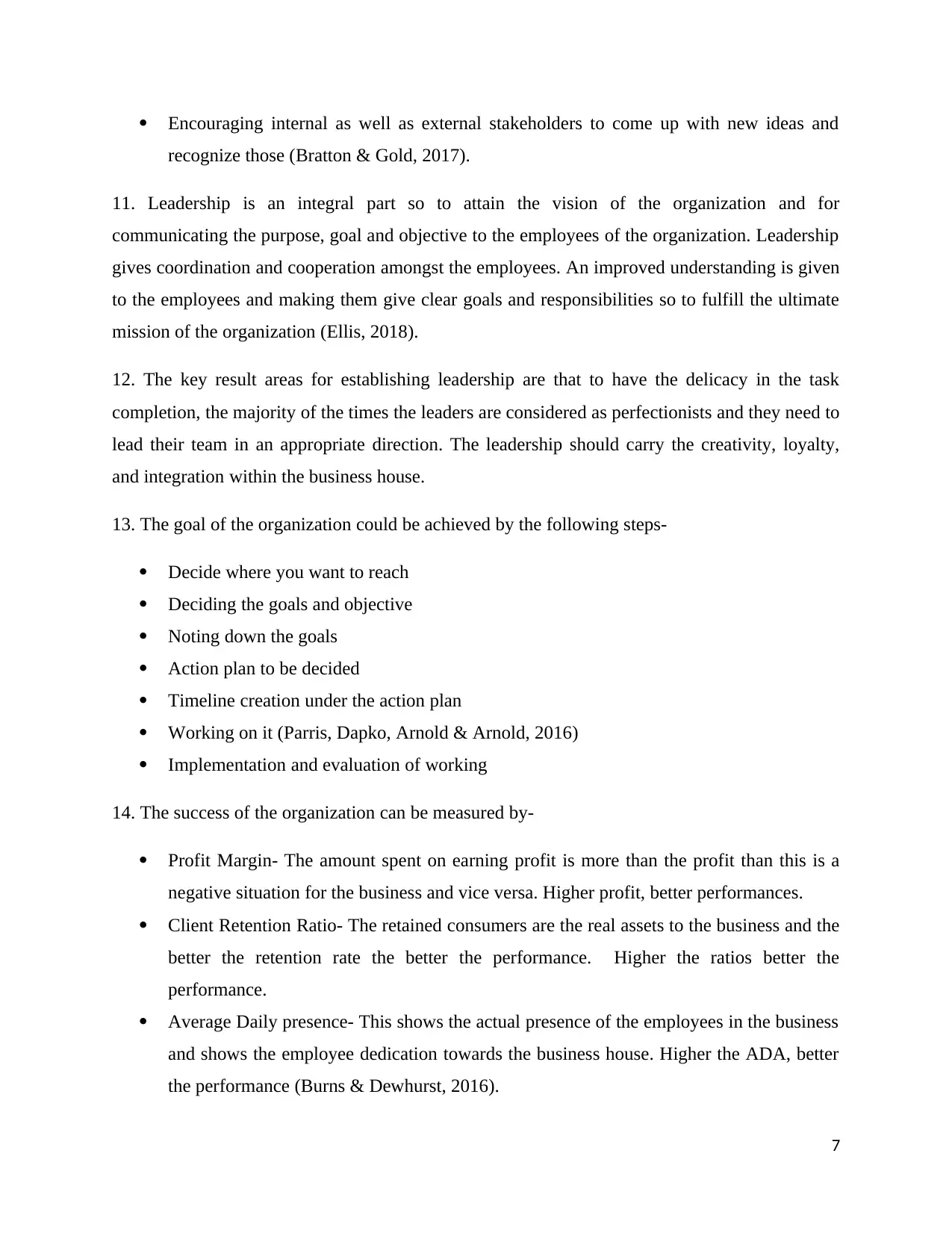
Encouraging internal as well as external stakeholders to come up with new ideas and
recognize those (Bratton & Gold, 2017).
11. Leadership is an integral part so to attain the vision of the organization and for
communicating the purpose, goal and objective to the employees of the organization. Leadership
gives coordination and cooperation amongst the employees. An improved understanding is given
to the employees and making them give clear goals and responsibilities so to fulfill the ultimate
mission of the organization (Ellis, 2018).
12. The key result areas for establishing leadership are that to have the delicacy in the task
completion, the majority of the times the leaders are considered as perfectionists and they need to
lead their team in an appropriate direction. The leadership should carry the creativity, loyalty,
and integration within the business house.
13. The goal of the organization could be achieved by the following steps-
Decide where you want to reach
Deciding the goals and objective
Noting down the goals
Action plan to be decided
Timeline creation under the action plan
Working on it (Parris, Dapko, Arnold & Arnold, 2016)
Implementation and evaluation of working
14. The success of the organization can be measured by-
Profit Margin- The amount spent on earning profit is more than the profit than this is a
negative situation for the business and vice versa. Higher profit, better performances.
Client Retention Ratio- The retained consumers are the real assets to the business and the
better the retention rate the better the performance. Higher the ratios better the
performance.
Average Daily presence- This shows the actual presence of the employees in the business
and shows the employee dedication towards the business house. Higher the ADA, better
the performance (Burns & Dewhurst, 2016).
7
recognize those (Bratton & Gold, 2017).
11. Leadership is an integral part so to attain the vision of the organization and for
communicating the purpose, goal and objective to the employees of the organization. Leadership
gives coordination and cooperation amongst the employees. An improved understanding is given
to the employees and making them give clear goals and responsibilities so to fulfill the ultimate
mission of the organization (Ellis, 2018).
12. The key result areas for establishing leadership are that to have the delicacy in the task
completion, the majority of the times the leaders are considered as perfectionists and they need to
lead their team in an appropriate direction. The leadership should carry the creativity, loyalty,
and integration within the business house.
13. The goal of the organization could be achieved by the following steps-
Decide where you want to reach
Deciding the goals and objective
Noting down the goals
Action plan to be decided
Timeline creation under the action plan
Working on it (Parris, Dapko, Arnold & Arnold, 2016)
Implementation and evaluation of working
14. The success of the organization can be measured by-
Profit Margin- The amount spent on earning profit is more than the profit than this is a
negative situation for the business and vice versa. Higher profit, better performances.
Client Retention Ratio- The retained consumers are the real assets to the business and the
better the retention rate the better the performance. Higher the ratios better the
performance.
Average Daily presence- This shows the actual presence of the employees in the business
and shows the employee dedication towards the business house. Higher the ADA, better
the performance (Burns & Dewhurst, 2016).
7
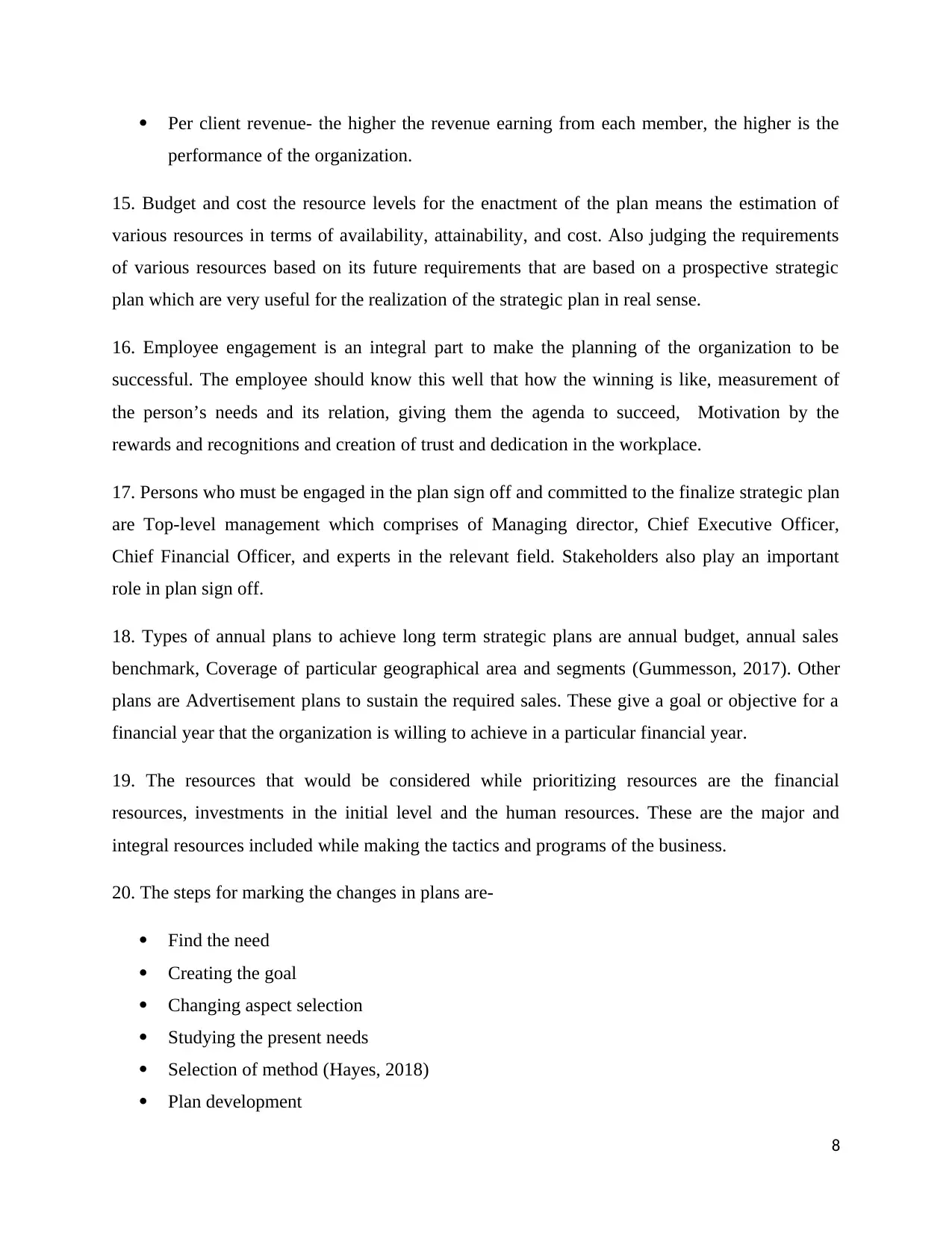
Per client revenue- the higher the revenue earning from each member, the higher is the
performance of the organization.
15. Budget and cost the resource levels for the enactment of the plan means the estimation of
various resources in terms of availability, attainability, and cost. Also judging the requirements
of various resources based on its future requirements that are based on a prospective strategic
plan which are very useful for the realization of the strategic plan in real sense.
16. Employee engagement is an integral part to make the planning of the organization to be
successful. The employee should know this well that how the winning is like, measurement of
the person’s needs and its relation, giving them the agenda to succeed, Motivation by the
rewards and recognitions and creation of trust and dedication in the workplace.
17. Persons who must be engaged in the plan sign off and committed to the finalize strategic plan
are Top-level management which comprises of Managing director, Chief Executive Officer,
Chief Financial Officer, and experts in the relevant field. Stakeholders also play an important
role in plan sign off.
18. Types of annual plans to achieve long term strategic plans are annual budget, annual sales
benchmark, Coverage of particular geographical area and segments (Gummesson, 2017). Other
plans are Advertisement plans to sustain the required sales. These give a goal or objective for a
financial year that the organization is willing to achieve in a particular financial year.
19. The resources that would be considered while prioritizing resources are the financial
resources, investments in the initial level and the human resources. These are the major and
integral resources included while making the tactics and programs of the business.
20. The steps for marking the changes in plans are-
Find the need
Creating the goal
Changing aspect selection
Studying the present needs
Selection of method (Hayes, 2018)
Plan development
8
performance of the organization.
15. Budget and cost the resource levels for the enactment of the plan means the estimation of
various resources in terms of availability, attainability, and cost. Also judging the requirements
of various resources based on its future requirements that are based on a prospective strategic
plan which are very useful for the realization of the strategic plan in real sense.
16. Employee engagement is an integral part to make the planning of the organization to be
successful. The employee should know this well that how the winning is like, measurement of
the person’s needs and its relation, giving them the agenda to succeed, Motivation by the
rewards and recognitions and creation of trust and dedication in the workplace.
17. Persons who must be engaged in the plan sign off and committed to the finalize strategic plan
are Top-level management which comprises of Managing director, Chief Executive Officer,
Chief Financial Officer, and experts in the relevant field. Stakeholders also play an important
role in plan sign off.
18. Types of annual plans to achieve long term strategic plans are annual budget, annual sales
benchmark, Coverage of particular geographical area and segments (Gummesson, 2017). Other
plans are Advertisement plans to sustain the required sales. These give a goal or objective for a
financial year that the organization is willing to achieve in a particular financial year.
19. The resources that would be considered while prioritizing resources are the financial
resources, investments in the initial level and the human resources. These are the major and
integral resources included while making the tactics and programs of the business.
20. The steps for marking the changes in plans are-
Find the need
Creating the goal
Changing aspect selection
Studying the present needs
Selection of method (Hayes, 2018)
Plan development
8
⊘ This is a preview!⊘
Do you want full access?
Subscribe today to unlock all pages.

Trusted by 1+ million students worldwide
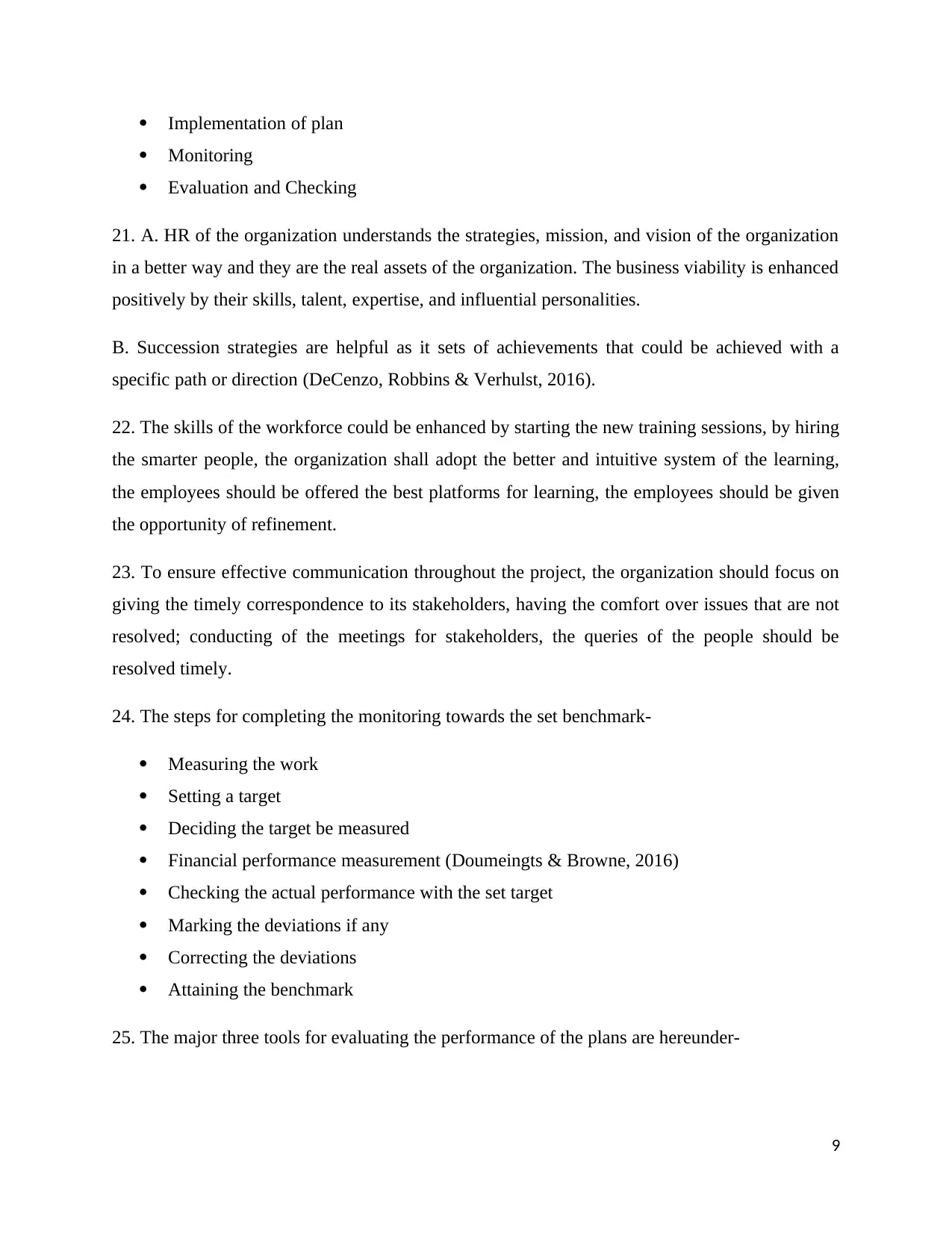
Implementation of plan
Monitoring
Evaluation and Checking
21. A. HR of the organization understands the strategies, mission, and vision of the organization
in a better way and they are the real assets of the organization. The business viability is enhanced
positively by their skills, talent, expertise, and influential personalities.
B. Succession strategies are helpful as it sets of achievements that could be achieved with a
specific path or direction (DeCenzo, Robbins & Verhulst, 2016).
22. The skills of the workforce could be enhanced by starting the new training sessions, by hiring
the smarter people, the organization shall adopt the better and intuitive system of the learning,
the employees should be offered the best platforms for learning, the employees should be given
the opportunity of refinement.
23. To ensure effective communication throughout the project, the organization should focus on
giving the timely correspondence to its stakeholders, having the comfort over issues that are not
resolved; conducting of the meetings for stakeholders, the queries of the people should be
resolved timely.
24. The steps for completing the monitoring towards the set benchmark-
Measuring the work
Setting a target
Deciding the target be measured
Financial performance measurement (Doumeingts & Browne, 2016)
Checking the actual performance with the set target
Marking the deviations if any
Correcting the deviations
Attaining the benchmark
25. The major three tools for evaluating the performance of the plans are hereunder-
9
Monitoring
Evaluation and Checking
21. A. HR of the organization understands the strategies, mission, and vision of the organization
in a better way and they are the real assets of the organization. The business viability is enhanced
positively by their skills, talent, expertise, and influential personalities.
B. Succession strategies are helpful as it sets of achievements that could be achieved with a
specific path or direction (DeCenzo, Robbins & Verhulst, 2016).
22. The skills of the workforce could be enhanced by starting the new training sessions, by hiring
the smarter people, the organization shall adopt the better and intuitive system of the learning,
the employees should be offered the best platforms for learning, the employees should be given
the opportunity of refinement.
23. To ensure effective communication throughout the project, the organization should focus on
giving the timely correspondence to its stakeholders, having the comfort over issues that are not
resolved; conducting of the meetings for stakeholders, the queries of the people should be
resolved timely.
24. The steps for completing the monitoring towards the set benchmark-
Measuring the work
Setting a target
Deciding the target be measured
Financial performance measurement (Doumeingts & Browne, 2016)
Checking the actual performance with the set target
Marking the deviations if any
Correcting the deviations
Attaining the benchmark
25. The major three tools for evaluating the performance of the plans are hereunder-
9
Paraphrase This Document
Need a fresh take? Get an instant paraphrase of this document with our AI Paraphraser
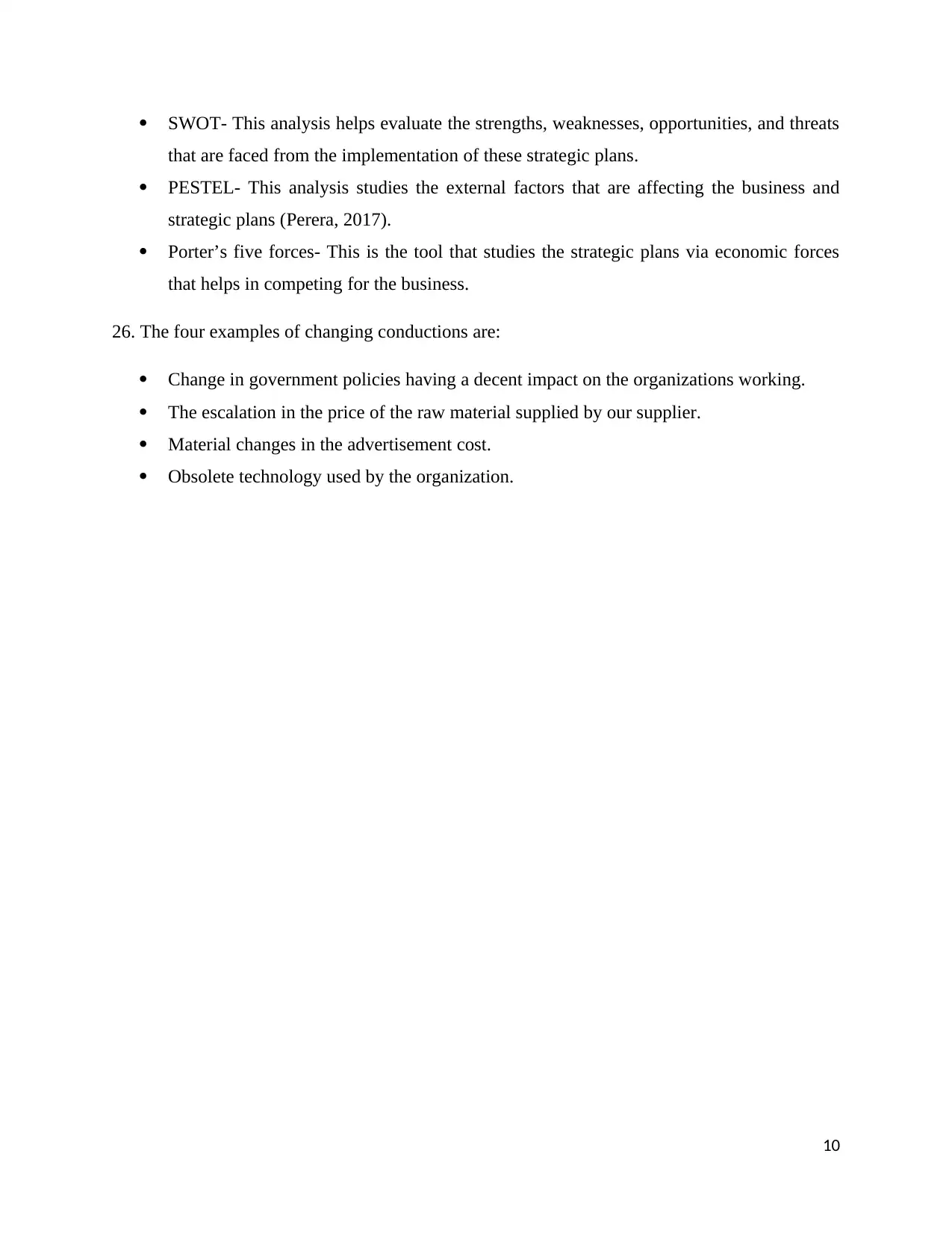
SWOT- This analysis helps evaluate the strengths, weaknesses, opportunities, and threats
that are faced from the implementation of these strategic plans.
PESTEL- This analysis studies the external factors that are affecting the business and
strategic plans (Perera, 2017).
Porter’s five forces- This is the tool that studies the strategic plans via economic forces
that helps in competing for the business.
26. The four examples of changing conductions are:
Change in government policies having a decent impact on the organizations working.
The escalation in the price of the raw material supplied by our supplier.
Material changes in the advertisement cost.
Obsolete technology used by the organization.
10
that are faced from the implementation of these strategic plans.
PESTEL- This analysis studies the external factors that are affecting the business and
strategic plans (Perera, 2017).
Porter’s five forces- This is the tool that studies the strategic plans via economic forces
that helps in competing for the business.
26. The four examples of changing conductions are:
Change in government policies having a decent impact on the organizations working.
The escalation in the price of the raw material supplied by our supplier.
Material changes in the advertisement cost.
Obsolete technology used by the organization.
10
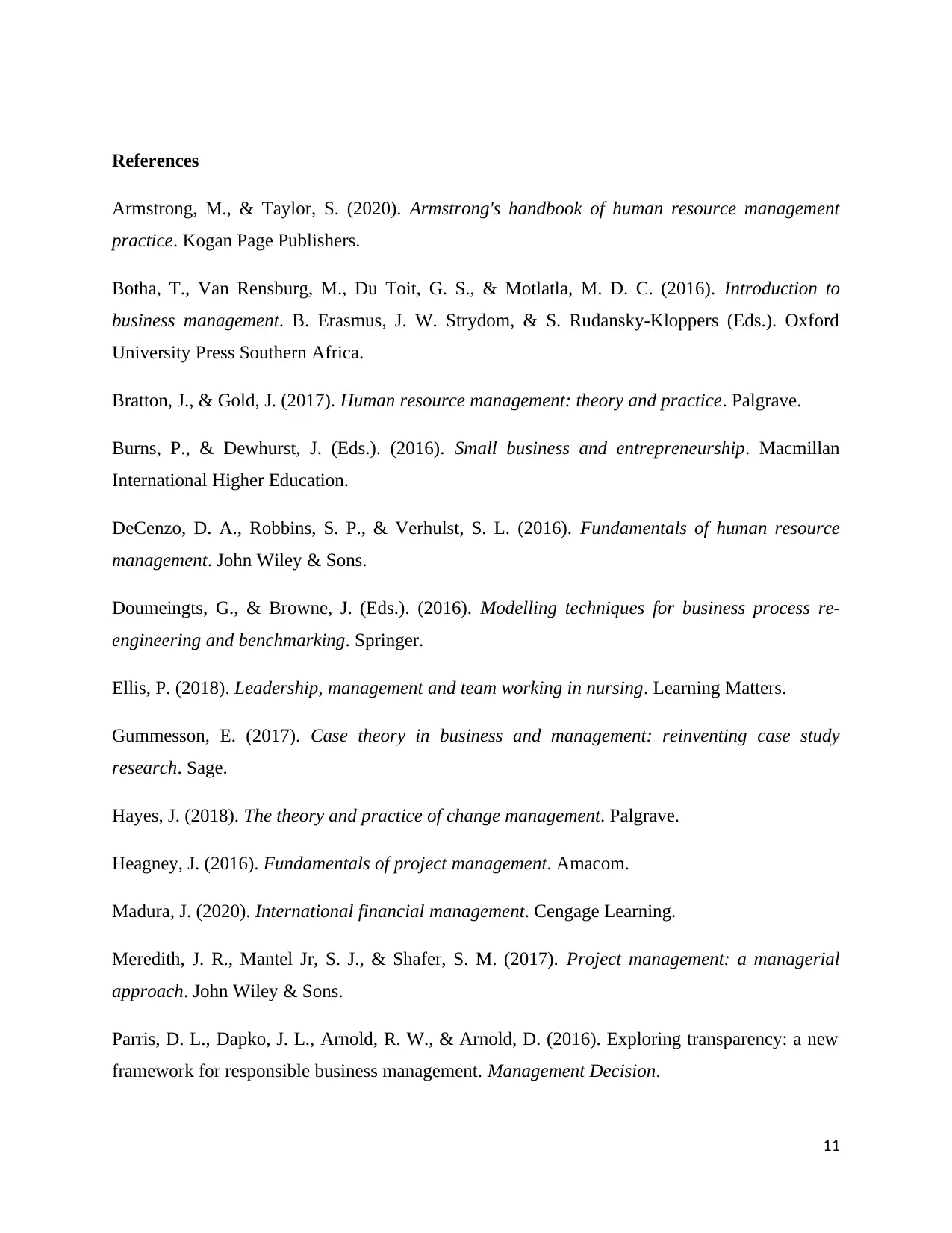
References
Armstrong, M., & Taylor, S. (2020). Armstrong's handbook of human resource management
practice. Kogan Page Publishers.
Botha, T., Van Rensburg, M., Du Toit, G. S., & Motlatla, M. D. C. (2016). Introduction to
business management. B. Erasmus, J. W. Strydom, & S. Rudansky-Kloppers (Eds.). Oxford
University Press Southern Africa.
Bratton, J., & Gold, J. (2017). Human resource management: theory and practice. Palgrave.
Burns, P., & Dewhurst, J. (Eds.). (2016). Small business and entrepreneurship. Macmillan
International Higher Education.
DeCenzo, D. A., Robbins, S. P., & Verhulst, S. L. (2016). Fundamentals of human resource
management. John Wiley & Sons.
Doumeingts, G., & Browne, J. (Eds.). (2016). Modelling techniques for business process re-
engineering and benchmarking. Springer.
Ellis, P. (2018). Leadership, management and team working in nursing. Learning Matters.
Gummesson, E. (2017). Case theory in business and management: reinventing case study
research. Sage.
Hayes, J. (2018). The theory and practice of change management. Palgrave.
Heagney, J. (2016). Fundamentals of project management. Amacom.
Madura, J. (2020). International financial management. Cengage Learning.
Meredith, J. R., Mantel Jr, S. J., & Shafer, S. M. (2017). Project management: a managerial
approach. John Wiley & Sons.
Parris, D. L., Dapko, J. L., Arnold, R. W., & Arnold, D. (2016). Exploring transparency: a new
framework for responsible business management. Management Decision.
11
Armstrong, M., & Taylor, S. (2020). Armstrong's handbook of human resource management
practice. Kogan Page Publishers.
Botha, T., Van Rensburg, M., Du Toit, G. S., & Motlatla, M. D. C. (2016). Introduction to
business management. B. Erasmus, J. W. Strydom, & S. Rudansky-Kloppers (Eds.). Oxford
University Press Southern Africa.
Bratton, J., & Gold, J. (2017). Human resource management: theory and practice. Palgrave.
Burns, P., & Dewhurst, J. (Eds.). (2016). Small business and entrepreneurship. Macmillan
International Higher Education.
DeCenzo, D. A., Robbins, S. P., & Verhulst, S. L. (2016). Fundamentals of human resource
management. John Wiley & Sons.
Doumeingts, G., & Browne, J. (Eds.). (2016). Modelling techniques for business process re-
engineering and benchmarking. Springer.
Ellis, P. (2018). Leadership, management and team working in nursing. Learning Matters.
Gummesson, E. (2017). Case theory in business and management: reinventing case study
research. Sage.
Hayes, J. (2018). The theory and practice of change management. Palgrave.
Heagney, J. (2016). Fundamentals of project management. Amacom.
Madura, J. (2020). International financial management. Cengage Learning.
Meredith, J. R., Mantel Jr, S. J., & Shafer, S. M. (2017). Project management: a managerial
approach. John Wiley & Sons.
Parris, D. L., Dapko, J. L., Arnold, R. W., & Arnold, D. (2016). Exploring transparency: a new
framework for responsible business management. Management Decision.
11
⊘ This is a preview!⊘
Do you want full access?
Subscribe today to unlock all pages.

Trusted by 1+ million students worldwide
1 out of 13
Related Documents
Your All-in-One AI-Powered Toolkit for Academic Success.
+13062052269
info@desklib.com
Available 24*7 on WhatsApp / Email
![[object Object]](/_next/static/media/star-bottom.7253800d.svg)
Unlock your academic potential
Copyright © 2020–2025 A2Z Services. All Rights Reserved. Developed and managed by ZUCOL.





